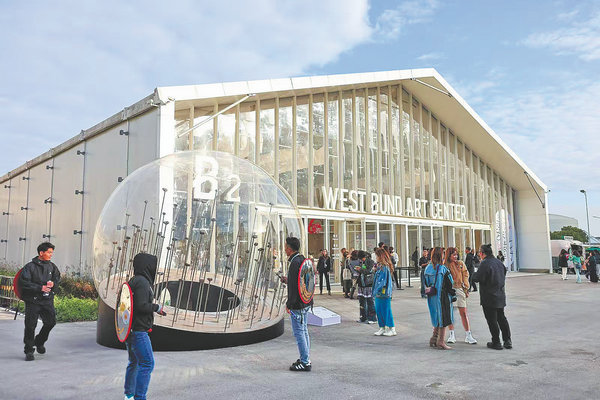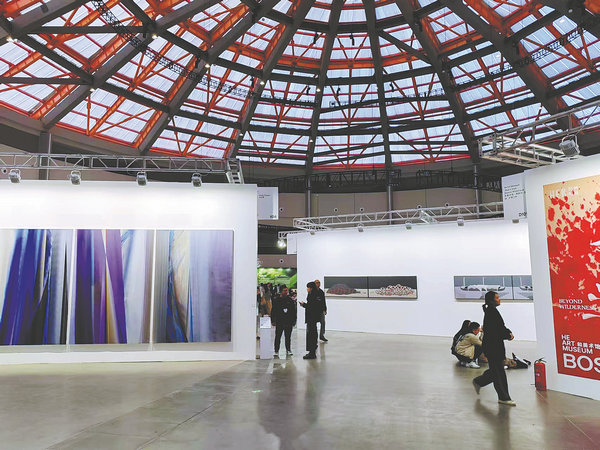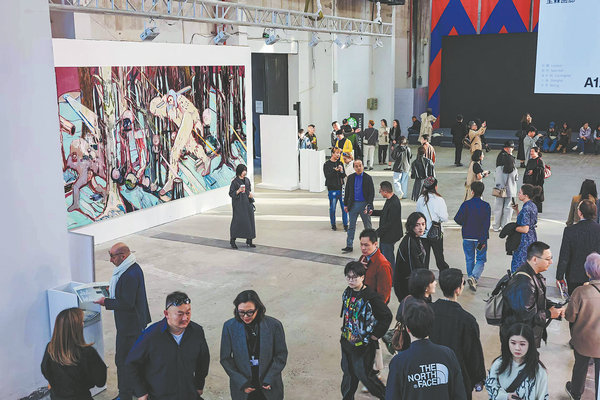 West Bund Art and Design is larger and broader this year in scale and numbers of exhibitors involved, showcasing artworks more valuable than during any of its previous 10 sessions since its founding in 2014. [Photo provided to China Daily]
West Bund Art and Design is larger and broader this year in scale and numbers of exhibitors involved, showcasing artworks more valuable than during any of its previous 10 sessions since its founding in 2014. [Photo provided to China Daily]
The 6th Shanghai International Art Trade Week, which ran from Nov 7 to 11, witnessed the recovery of the art market and its rising public enthusiasm. More than 300 art institutions from home and abroad presented 125 events showcasing more than 10,000 masterpieces.
Since its first edition in 2019, the annual art week “has vigorously accelerated Shanghai’s aim of becoming an important international art trade center”, Zhong Xiaomin, head of the Municipal Administration of Culture and Tourism, said on Nov 7 at the opening of West Bund Art and Design, which is a flagship event of the international art trade week.
Following other major international art trading centers such as New York, London and Paris, Shanghai claimed the week in early November each year as its allocated period for global art trade, as this time sees hundreds of galleries and institutions from around the world meeting up to do business in Shanghai, holding more than 100 fairs, exhibitions and other events around the city, she said.
 Art enthusiasts flock to the West Bund Art and Design, a key part of the 6th Shanghai International Art Trade Week, in November. [Photo provided to China Daily]
Art enthusiasts flock to the West Bund Art and Design, a key part of the 6th Shanghai International Art Trade Week, in November. [Photo provided to China Daily]
This year, West Bund Art and Design was larger and broader, showcasing artworks more valuable than any of its previous 10 sessions since its founding in 2014.The international art fair brought together more than 170 galleries, exhibitors and institutions from 54 cities in 24 countries and regions from Nov 8 to 10. More than 4,500 artworks were showcased, a 20 percent increase from last year. The value of the exhibits totaled approximately 1.5 billion yuan ($207.84 million), an increase of 150 percent from the previous year.
The fair expanded southward to several new venues along the Huangpu River, such as the Orbit, an artistic center on Longteng Avenue, and Gate M, a commercial center redesigned from a hundred-year-old cement factory, both located on the West Bund, that officially kicked off the further expansion of the West Bund region, which refers to the Xuhui Waterfront along the Huangpu River.
It will extend as far as the Xupu Bridge area, where a new art-themed park is planned and calls will open for international proposals for a new landmark structure that integrates sport, cultural activities and live performances.
Timothy Taylor, founding director of the Timothy Taylor Gallery from London, has participated in the West Bund Art and Design for nine consecutive years. He notices that the collector base “has broadened enormously” during this period. Art buyers in Shanghai are well-traveled, incredibly well-informed and more international — “They understand the artists that we are representing”, he told China Daily at the fair.
 Art enthusiasts flock to the West Bund Art and Design, a key part of the 6th Shanghai International Art Trade Week, in November. [Photo provided to China Daily]
Art enthusiasts flock to the West Bund Art and Design, a key part of the 6th Shanghai International Art Trade Week, in November. [Photo provided to China Daily]
Through the years, the gallery has presented solo exhibitions in Shanghai for important artists, such as Alex Katz and Annie Morris. This year, the gallery joined hands with the Long Museum in Shanghai to present Immortals, a solo exhibition of paintings by British artist Daniel Crews-Chubb, from Nov 7 to Jan 5.
“This is like Frieze London,” Crews-Chubb says, referring to one of the world’s most influential contemporary art fairs that takes place each October in London’s Regent’s Park. “It’s very busy, very bustling. A lot of the art worlds are here; all of the major galleries are here. All of the powerhouse galleries seem to do both of these fairs — the West Bund and Art021, and more. It’s very energetic.”
Hauser & Wirth, an international gallery, with locations in Zurich, London, New York, and other major cities, is also a regular participant in West Bund Art and Design. The gallery presented paintings, installations and conceptual artworks at the fair spanning a wide range of prices from $10,000 to $1 million.
A conceptual work priced at $150,000 by British artist Martin Creed featuring stripes of white and blue paint on the wall attracted wide interest at the gallery’s booth.
“A few art museums are very interested in the piece and talked to us about it,” Lihsin Tsai, senior director of the gallery, told China Daily on opening day. “We have confidence in the potential and acceptance of the Chinese market, collectors and institutions, so we hope to bring something newer and better to the West Bund every year,” she said.
 ART021, another key fair for the week, sees Shanghai’s art market picking up momentum. [Photo provided to China Daily]
ART021, another key fair for the week, sees Shanghai’s art market picking up momentum. [Photo provided to China Daily]
Art021, another important fair for the art week, received more than 60,000 visitors from Nov 7 to 11 at the Shanghai Exhibition Center, where 131 galleries and institutions presented exhibitions from 43 cities in 20 countries and regions. About half the participants were domestic galleries, with 30 percent making their debut.
ART021 sees Shanghai’s art market picking up momentum, with new galleries participating and art enthusiasts buying original work.
Zhou Dawei, co-founder of ART021, says that aside from Western art institutions, this year the fair invited galleries from countries involved with the Belt and Road Initiative, presenting a “real international outlook of the art world”, he says.
Compared to established art fairs such as Art Basel in Switzerland, “we are still young, and our core mission is to promote contemporary Chinese art. We are going to establish a distinctive identity centered in the global art scene”, Zhou says.
The Hive Center for Contemporary Art from Beijing has been a regular participant in all 12 sessions of Art021.
Xia Jifeng, director of the center, says: “We had the largest booth this year and presented a series of the most sought-after artists. We achieved very good sales, more than we expected, though the art market is still going through a turbulent period of adjustment.”
Swiss bank UBS shared its findings regarding China’s art market at West Bund Art and Design. According to the Art Basel and UBS Survey of Global Collecting 2024, which was authored by Clare McAndrew, founder of Arts Economics, high-net-worth individuals from the Chinese mainland had the highest expenditure on art and antiques in 2023, as well as the first half of 2024, with a median of $97,000, more than double of that of any other region.
This suggests that the strong return of post-pandemic spending has been sustained, says Marina Lui, head of Wealth Management China, UBS Global Wealth Management.
,https://english.shanghai.gov.cn/en-Latest-WhatsNew/20241115/ad9713a76a684e369557148a03439e4c.html
